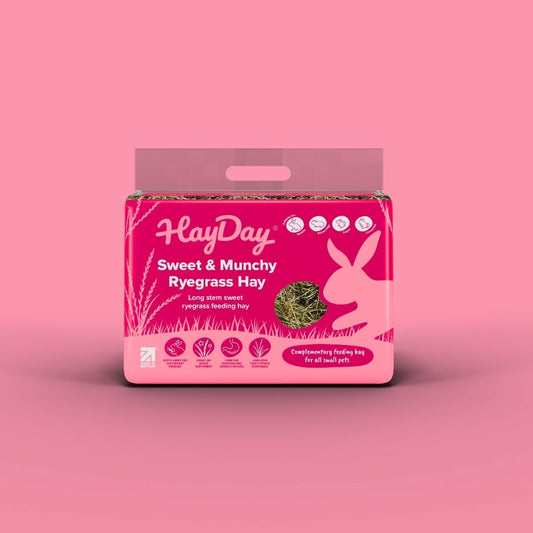If your rabbit suddenly stops eating, it may be experiencing GI stasis, a severe digestive condition that demands immediate attention.
So, what is GI stasis in rabbits? This common but potentially life-threatening issue can cause your bunny's belly to stop working properly and create a toxic imbalance (Oglesbee and Lord, 2020).
Whilst not veterinary advice, in this guide, our experts at HayDay will explain the signs of GI stasis, explore its causes, and outline the necessary steps for treatment to help your rabbit recover.
A high fibre diet (hay) is a key factor for preventing GI Statsis - Shop hay for your rabbit here >
Gastrointestinal Stasis in Rabbits Overview
-
GI Stasis in rabbits is a potentially dangerous condition characterised by the slowdown or stoppage of gut motility, which can be caused by improper diet, stress, or underlying health issues (Oglesbee and Lord, 2020).
-
Recognising the signs of GI Stasis is important for early intervention and can include symptoms like abdominal discomfort, changes in eating habits, including reduced caecotroph consumption, and decreased or altered faecal output (Duxbury, 2021).
-
Treatment for GI Stasis includes fluid therapy, pain management, and nutritional support, while preventative strategies involve maintaining a high-fibre diet, ensuring a stress-free environment, and regular veterinary check-ups (Duxbury, 2021).
What is GI Stasis in Rabbits?
Gastrointestinal stasis, often shortened to GI Stasis, manifests as a slowdown or complete stoppage in the movement of food through the rabbit’s digestive system. This results in an imbalance of bacteria in the intestinal tract, leading to a host of problems (Oglesbee and Lord, 2020).
The rabbit’s gut, also known as the rabbit’s digestive system, is a finely tuned machine that requires a steady intake of indigestible fibre to maintain its normal function.
A rabbit’s diet plays a vital role in preventing GI stasis - Consuming grass hay, for instance, helps maintain the rabbit’s teeth and aids in normal gut motility.
However, inappropriate dietary choices, such as low fibre intake (not enough hay!), can negatively affect the pH levels in the GI tract. This can, in turn, promote the growth of harmful gas-producing bacteria, resulting in pain, potentially fatal toxins, and, ultimately, a rabbit in distress.
Recognising the Signs of GI Stasis
Identifying the symptoms of GI stasis in affected rabbits paves the way for prompt and effective assistance. As the condition progresses, your rabbit’s appetite may gradually decrease over a period of 2 to 7 days, potentially leading to a complete stoppage of eating.
Symptoms of gastrointestinal disease, such as GI stasis, may not be clear-cut, but keen observation can be beneficial. Now, let’s focus on specific symptoms indicative of this condition: abdominal discomfort, altered eating habits, and changes in faecal output.
Abdominal Discomfort
Abdominal discomfort is a telltale sign of GI stasis in rabbits. You may notice your rabbit acting less social, showing reluctance to move, or even sitting in a hunched position. These are all indications of severe abdominal pain.
What causes this discomfort?
It’s primarily due to gas-producing bacteria. When a rabbit stops eating, the pH of their gastrointestinal tract changes, leading to an overgrowth of these bacteria.
The gas these bacteria produce can cause severe pain and significantly reduce the rabbit’s willingness to eat, exacerbating the condition. Such a cycle intensifies the condition, thereby perpetuating GI stasis.
Changes in Eating Habits
Alterations in your rabbit’s feeding patterns may also hint at GI stasis. Factors such as stress from environmental changes or a sudden shift in diet can lead to a rabbit eating less. Conditions like stomach ulcers can also cause significant pain, leading to decreased food intake.
Another important observation is whether your rabbit is consuming its caecotrophs. Caecotrophs are nutrient-rich faecal pellets that rabbits normally consume. If your rabbit is not doing so, this could indicate discomfort or pain associated with GI stasis.
Faecal Output Observations
Keeping an eye on your rabbit’s faecal output is vital for diagnosing GI stasis. A decrease in faecal output or a change in the faeces' consistency can indicate the condition.
Observing smaller or misshapen faecal pellets can also suggest a reduction in food intake or slow gut motility, both signs of GI stasis. A complete cessation of faecal output is a severe symptom and requires immediate veterinary attention.
What are the Causes Of GI Stasis in Rabbits?
Several factors can contribute to GI stasis. One of the leading causes is dietary mismanagement, such as inadequate fibre intake.
A diet primarily consisting of pellets and high-carbohydrate, high-fat treats without sufficient fresh hay can predispose rabbits to GI stasis.
Additionally, various underlying health issues can result in GI stasis.
From dental disease to neurological disorders, these health complications can interfere with the normal functioning of the rabbit’s GI tract, leading to GI stasis. Now, let’s understand these causes more thoroughly.
Shop premium quality, high fibre hay for your rabbits here.
Dietary Mismanagement
When it comes to a rabbit’s diet, fibre is king.
Diets low in fibre and high in carbohydrates can slow down chocoholic motility, leading to GI stasis. Low fibre intake can also alter the bacteria in a rabbit’s GI tract and decrease muscle contractions, both of which can lead to potential GI stasis.
Furthermore, a fibre-rich diet not only stimulates normal intestinal motility but also helps maintain dental health by wearing down the rabbit’s continuously growing teeth. Clearly, your rabbit's diet significantly affects their gastrointestinal health.
Our rabbit hay is a great high fibre option for your rabbits.

Health Complications
Apart from diet, various health complications can also contribute to GI stasis. Dental problems, such as malocclusion or abscesses, can cause pain during chewing, therefore rabbits stop eating and GI stasis.
Liver and kidney diseases can result in:
-
Decreased appetite
-
Dehydration
-
Decreased GI motility
-
Periods of immobility
Therefore, rabbits with frequent GI stasis should be assessed for chronic underlying health issues, as these can predispose them to recurrent episodes of the condition.
Seeking Vets Advice & Diagnosis
Diagnosing GI stasis in rabbits involves a comprehensive physical examination, during which a vet will look for signs such as bloating and decreased stool production. They will also inquire about the rabbit’s eating and drinking habits.
Along with physical examinations, diagnostic tools like X-rays and bloodwork analysis provide essential information about the rabbit’s health and help identify underlying diseases that can precipitate GI stasis. Now, let’s explore these diagnostic techniques more comprehensively.
Blood Glucose Levels as Indicators
Blood glucose measurement is a quick screening tool for rabbits with suspected intestinal obstruction. It’s a measurable parameter that can be used to assess the severity of a rabbit’s condition regarding anorexia, a common symptom of GI stasis (Oglesbee and Lord, 2020).
Getting a Scan & Imaging Techniques
Beyond blood tests, imaging techniques like X-rays, CT scans, and ultrasound imaging play a pivotal role in diagnosing GI stasis and identifying underlying causes (Oglesbee and Lord, 2020).
Abdominal radiographs or X-rays are commonly used as initial diagnostic tools to detect potential intestinal obstructions or foreign bodies in rabbits with GI stasis.
CT imaging and ultrasound imaging provide even more detailed perspectives. CT scans offer high-quality images without structure superimposition, aiding in assessments of the GI system.
Ultrasound imaging, on the other hand, is beneficial for evaluating gastrointestinal motility and identifying obstructions or foreign objects that radiographs may not show.
Treatment for Rabbit GI Stasis Symptoms
Treating GI stasis in rabbits involves a multi-faceted approach, including fluid therapy, nutritional support, and appropriate medications (Oglesbee and Lord, 2020).
Fluid therapy is an effective GI stasis treatment, often using warmed, isotonic fluids administered depending on the severity of dehydration.
Nutritional support is also vital. This can be provided through syringe feeding with formulas like Critical Care when rabbits refuse to eat.
Providing fragrant greens and fresh hay can also entice rabbits to feed naturally. Now, let’s examine these treatment approaches in greater detail.
Rehydration Nutritional Support
Hydration is key in the recovery of rabbits with GI stasis. Rabbits that are severely dehydrated and have not eaten for more than 1 to 2 days often need to be hospitalised for intravenous fluid therapy. This treatment helps to restore their hydration and support their recovery.
Fluid therapy is critical for restoring hydration in both the rabbit and its stomach contents. Assisted feeding with foods high in water content can aid in rehydrating the gastrointestinal contents and stimulate normal motility.
Medication and Pain Management
Managing pain is another critical aspect of treating GI stasis in rabbits. After all, untreated pain can cause rabbits to stop eating and drinking, which only exacerbates the condition.
Medications can be used to alleviate pain and promote gut movement. Prokinetic agents can also be used to stimulate gastrointestinal motility.
Preventative Measures to Avoid GI Stasis
While knowing how to treat GI stasis is critical, prevention is always better than cure. Providing a high-fibre, hay-based diet with supplemental vegetables and limited fruit helps maintain proper gut function and prevent GI stasis.
Stress also plays a significant role in GI motility. Therefore, providing a stress-free environment with enrichment and toys is beneficial in preventing GI stasis. Regular exercise and routine veterinary checkups are also vital in monitoring for and preventing the condition. Let’s further explore these preventative strategies.
High-Fibre Diet Essentials
A proper rabbit diet consists of:
-
Leafy green vegetables
-
Approximately an egg-cup of pellets
The fibre found in hay sustains normal gut motility and dental health, both of which are important for preventing GI stasis and maintaining a healthy digestive tract.
High-fibre diets also support digestive health by limiting non-structural carbohydrate (starch and sugar) availability.
Regular Veterinary Checkups
Routine veterinary examinations play a key role in preventing GI stasis. Through annual health exams, early signs of health issues that could escalate to serious risks like GI stasis can be caught.
Prompt intervention is key when it comes to pet rabbits. Monitoring your rabbit for abnormal behaviours and seeking immediate veterinary care can inhibit the rapid deterioration of conditions.
Summary
In conclusion, GI stasis is a serious condition that can significantly affect a rabbit’s health. Understanding the causes, symptoms, and treatment strategies of this condition is important for every rabbit owner.
Prevention, though, is the key to maintaining your rabbit’s health. A high-fibre diet, regular exercise, and routine veterinary checkups can go a long way in preventing the onset of this condition. So, here’s to happy, healthy rabbits!
Frequently Asked Questions
How do I know if my rabbit has GI stasis?
If your rabbit is crouched in a pile, shows no interest in food, and seems lethargic, it might have GI stasis. Start treatment immediately, as any abnormal behaviour should be addressed promptly.
Can GI stasis in rabbits be cured?
Yes, stasis in rabbits can usually be treated if caught quickly, as it can be caused by various factors such as fur ingestion, stress, or gas bubbles. It is important to address the underlying cause promptly to help the rabbit recover.
References
Duxbury, J. (2021) Managing gastro-intestinal stasis in hospitalised rabbits: a literature review, Veterinary Nursing Journal, 36:1, 24-29, DOI: 10.1080/17415349.2020.1795020
Faulkner, B. (2023) Your Ultimate Guide to Gastrointestinal Stasis in Rabbits. [Online]
Jones, L. (2023) Gastrointestinal (GI) Stasis in Rabbits. [Online]
Oglesbee, B.L, Lord, B. (2020) Gastrointestinal Diseases of Rabbits. Ferrets, Rabbits, and Rodents. Clinical Medicine and Surgery, 174–87. doi: 10.1016/B978-0-323-48435-0.00014-9.





